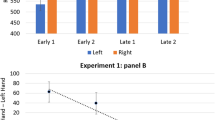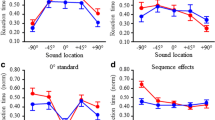Abstract
Both spatial and temporal attention improves auditory processing and these effects seem to originate at perceptual processing stages. It is not yet known if space and time are used in parallel or sequentially for stimulus selection. To directly compare when temporal and spatial attention affect stimulus processing in the auditory modality, short and long empty intervals (600 and 1,200 ms) were presented. Each interval started with a centrally presented tone (S1) and ended with a second tone (S2) presented either on the left or on the right side. Participants had to attend one point in time (offset of the short or long interval) and one position (left or right side) and had to respond to infrequent, deviant offset markers presented at the attended time point and at the attended position. The N1 of concurrently recorded event-related potentials (ERPs) to the frequent standard stimuli was enhanced by both temporal and spatial attention. The temporal and the spatial N1 attention effect had a similar scalp topography, suggesting common neural generators. By contrast, later effects of temporal and spatial attention, consisting of a posterior positivity and an anterior negativity, markedly differed.




Similar content being viewed by others
Notes
In a repeated measures ANOVA with the factors attended time (attended vs. unattended), stimulus position (left vs. right), attended position (left vs. right), hemisphere (left vs. right) and Cluster (seven levels), no significant interactions between hemisphere, stimulus position and attended position were observed (all P>0.1944), indicating that there was no lateralization of spatial attention effects depending on the position of the stimulus.
For standards presented after the long interval, a repeated-measures ANOVA with the factors attended time (attended vs. unattended), attended position (attended vs. unattended), hemisphere (contralateral vs. ipsilateral), and cluster (seven levels) was conducted. The mean amplitude of the time interval 90–130 ms was submitted as dependent variable. Effects of both temporal attention (attended time: F(1, 11)=16.34, P=0.0019, attended time × cluster: F(6, 66)=7.67, P=0.0011, ε=0.4294), and spatial attention (attended position × cluster: F(6, 66)=3.32, P=0.0329, ε=.4891) were significant.
References
Anllo-Vento L, Hillyard SA (1996) Selective attention to the color and direction of moving stimuli: electrophysiological correlates of hierarchical feature selection. Percept Psychophys 58:191–206
Buonomano DV, Karmarkar UR (2002) How do we tell time? Neuroscientist 8:42–51
Cohen YE, Knudsen EI (1999) Maps versus clusters: different representations of auditory space in the midbrain and forebrain. Trends Neurosci 22:128–135
Correa A, Lupiánez J, Milliken B, Tudela P (2004) Endogenous temporal orienting of attention in detection and discrimination tasks. Percept Psychophys 66:264–278
Coull JT, Nobre AC (1998) Where and when to pay attention: the neural systems for directing attention to spatial locations and to time intervals as revealed by both PET and fMRI. J Neurosci 18:7426–7435
Doherty JR, Rao A, Mesulam MM, Nobre AC (2005) Synergistic effect of combined temporal and spatial expectations on visual attention. J Neurosci 25:8259–8266
Eason RG (1981) Visual evoked potential correlates of early neural filtering during selective attention. Bull Psychon Soc 18:203–206
Eimer M (1995) Event-related potential correlates of transient attention shifts to color and location. Biol Psychol 41:167–182
Giard MH, Perrin F, Pernier J, Peronnet F (1988) Several attention-related wave forms in auditory areas: a topographic study. Electroencephalogr Clin Neurophysiol 69:371–384
Gibbon J, Church RM, Meck WH (1984) Scalar timing in memory. In: Gibbon J, Allan L (eds) Timing and time perception, vol 423. The New York Academy of Sciences, New York, pp 52–77
Green D, Swets J (1966) Signal detection theory and psychophysics. Wiley, New York
Griffin IC, Miniussi C, Nobre AC (2001) Orienting attention in time. Front Biosci 6:660–671
Griffin IC, Miniussi C, Nobre AC (2002) Multiple mechanisms of selective attention: differential modulation of stimulus processing by attention to space or time. Neuropsychologia 40:2325–2340
Hansen JC, Hillyard SA (1980) Endogenous brain potentials associated with selective auditory attention. Electroencephalogr Clin Neurophysiol 49:277–290
Hansen JC, Hillyard SA (1983) Selective attention to multidimensional auditory stimuli. J Exp Psychol Hum Percept Perform 9:1–19
Harter MR, Aine CJ (1984) Brain mechanisms of visual selective attention. In: Parasuraman R, Davies DR (eds) Varieties of attention. Academic, New York, pp 293–321
Harter MR, Guido W (1980) Attention to pattern orientation: negative cortical potentials, reaction time, and the selection process. Electroencephalogr Clin Neurophysiol 49:462–475
Heslenfeld DJ, Kenemans JL, Kok A, Molenaar PCM (1997) Feature processing and attention in the human visual system: an overview. Biol Psychol 45:183–215
Hillyard SA, Münte TF (1984) Selective attention to color and location: an analysis with event-related brain potentials. Percept Psychophys 36:185–198
Hillyard SA, Hink R, Schwent VL, Picton T (1973) Electrical signs of selective attention in the human brain. Science 162:177–180
Huynh H, Feldt LS (1976) Estimation of the box correction for degrees of freedom from sample data in randomized block and splitsplot designs. J Educ Stat 1:69–82
Lange K, Rösler F, Röder B (2003) Early processing stages are modulated when auditory stimuli are presented at an attended moment in time: an event-related potential study. Psychophysiology 40:806–817
Leon MI, Shadlen MN (2003) Representation of time by neurons in the posterior parietal cortex of the macaque. Neuron 38:317–327
Mangun GR (1995) Neural mechanisms of visual selective attention. Psychophysiology 32:4–18
Mauk MD, Buonomano DV (2004) The neural basis of temporal processing. Annu Rev Neurosci 27:307–340
McCarthy G, Wood CC (1985) Scalp distributions of event-related potentials: an ambiguity associated with analysis of variance models. Electroencephalogr Clin Neurophysiol 62:203–208
Middlebrooks JC (2000) Cortical representations of auditory space. In: Gazzaniga MS (ed) The new cognitive neurosciences. MIT Press, Cambridge, pp 425–436
Miniussi C, Wilding EL, Coull JT, Nobre AC (1999) Orienting attention in time. Modulation of brain potentials. Brain 122:1507–1518
Mondor TA, Zatorre RJ (1995) Shifting and focusing auditory spatial attention. J Exp Psychol Hum Percept Perform 21:387–409
Mondor TA, Zatorre RJ, Terrio NA (1998) Constraints on the selection of auditory information. J Exp Psychol Hum Percept Perform 24:66–79
Näätänen R (1982) Processing negativity: an evoked-potential reflection of selective attention. Psychol Bull 92:605–640
Näätänen R (1990) The role of attention in auditory information processing as revealed by event-related potentials and other brain measures of cognitive function. Behav Brain Sci 13:201–288
Näätänen R, Gaillard AWK, Mäntysalo S (1978) Early selective-attention effect on evoked potential reinterpreted. Acta Psychol 42:313–329
Näätänen R, Porkka R, Merisalo A, Ahtola S (1980) Location vs. frequency of pure tones as a basis of fast discrimination. Acta Psychol 44:31–40
Näätänen R, Teder W, Alho K, Lavikainen J (1992) Auditory attention and selective input modulation: a topographical ERP study. NeuroReport 3:493–496
Nobre AC (2001) Orienting attention to instants in time. Neuropsychologia 39:1317–1328
Nobre AC (2004) Probing the flexibility of attentional orienting in the human brain. In: Posner MI (ed) Cognitive neuroscience of attention. The Guilford Press, New York, pp 157–179
O’Brien RG, Kaiser MK (1985) MANOVA for analyzing repeated measurement design: an extensive primer. Psychol Bull 92:316–333
Posner MI (1980) Orienting of attention. Q J Exp Psychol 32:3–25
Spence C, Driver J (1994) Covert spatial orienting in audition: exogenous and endogenous mechanisms. J Exp Psychol Hum Percept Perform 20:555–574
Spence C, Pavani F, Driver J (2000) Crossmodal links between vision and touch in covert endogenous spatial attention. J Exp Psychol Hum Percept Perform 26:1298–1319
Teder-Sälejärvi WA, Hillyard SA, Röder B, Neville H (1999) Spatial attention to central and peripheral auditory stimuli as indexed by event-related potentials. Cogn Brain Res 8:213–227
Urbach TP, Kutas M (2002) The intractability of scaling scalp distributions to infer neuroelectric sources. Psychophysiology 39:791–808
Van Voorhis S, Hillyard SA (1977) Visual evoked potentials and attention to points in space. Percept Psychophys 22:54–62
Verleger R (1988) Event-related potentials and cognition: a critique of the context updating hypothesis and an alternative interpretation of P3. Behav Brain Sci 11:343–427
Woldorff MG, Hillyard SA (1991) Modulation of early auditory processing during selective listening to rapidly presented tones. Electroencephalogr Clin Neurophysiol 79:170–191
Woldorff MG, Gallen CC, Hampson SA, Hillyard SA, Pantev C, Sobel D, Bloom FE (1993) Modulation of early sensory processing in human auditory cortex during auditory selective attention. In: Proceedings of the National Academy of Sciences of the United States of America, vol 90, pp 8722–8726
Woods DL (1990) The physiological basis of selective attention: implications of event-related potential studies. In: Rohrbaugh JW, Parasuraman R, Johnson J (eds) Event-related brain potentials: basic issues and applications. Oxford University Press, New York, pp 178–209
Woods DL, Alain C (2001) Conjoining three auditory features: an event-related brain potential study. J Cogn Neurosci 13:492–509
Woods DL, Alho K, Algazi A (1994) Stages of auditory feature conjunction: an event-related brain potential study. J Exp Psychol Hum Percept Perform 20:81–94
Woods DL, Alain C, Ogawa KH (1998) Conjoining auditory and visual features during high-rate serial presentation: processing and conjoining two features can be faster than processing one. Percept Psychophys 60:239–249
Woods DL, Alain C, Diaz R, Rhodes D, Ogawa KH (2001) Location and frequency cues in auditory selective attention. J Exp Psychol Hum Percept Perform 27:65–74
Acknowledgements
The study was conducted at the Psychology Department of the Philipps-University, Marburg (Germany). The study was supported by grants Ro 1226/4-1, 4-2 and For 254/2-1, 2-2 to B.R. of the German Research Foundation (DFG)
Author information
Authors and Affiliations
Corresponding author
Rights and permissions
About this article
Cite this article
Lange, K., Krämer, U.M. & Röder, B. Attending points in time and space. Exp Brain Res 173, 130–140 (2006). https://doi.org/10.1007/s00221-006-0372-3
Received:
Accepted:
Published:
Issue Date:
DOI: https://doi.org/10.1007/s00221-006-0372-3




